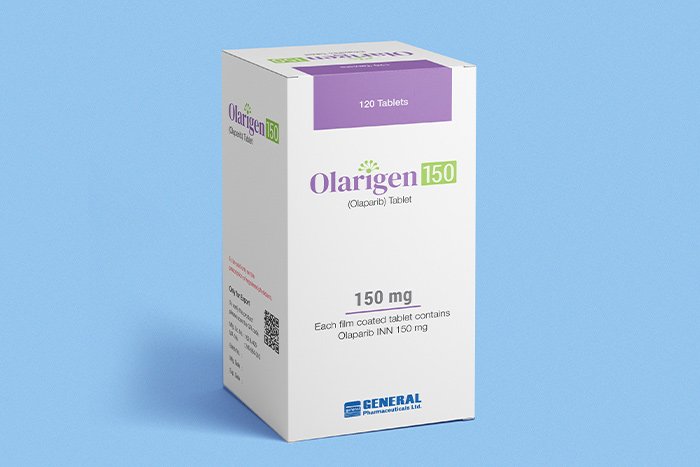Olaparib 150mg
0.00$
Olarigen tablets, comprising 150mg of Olaparib, serve as a therapeutic agent within oncology, primarily targeting specific cancer types like ovarian cancer, breast cancer, and prostate cancer. Falling under the category of poly (ADP-ribose) polymerase (PARP) inhibitors, Olaparib functions by impeding an enzyme crucial for repairing DNA damage within cancer cells. Healthcare providers prescribe Olarigen tablets as a component of a holistic treatment approach for patients fitting the criteria with these particular cancer types.
Olaparib 150 mg is an oral cancer treatment that specifically targets the disease and is known as a PARP (poly ADP-ribose polymerase) inhibitor. Its main application is in treating specific cancer types linked to BRCA mutations, such as ovarian, breast, pancreatic, and prostate cancers. Olaparib assists in minimizing tumor growth and advancement by disrupting cancer cells’ DNA repair capabilities, thus providing a more individualized strategy for cancer treatment.
Dosage Form and Strength:
Every tablet of Olaparib has 150 mg of the active substance. Though it comes in tablet form of 100 mg, the 150 mg dosage is preferred for treatment regimens to be simplified and to lessen the burden of pills.
Mechanism of Action:
Olaparib functions by inhibiting PARP enzymes, which are crucial for repairing single-strand DNA breaks. This repair mechanism preserves genomic stability in healthy cells. Nonetheless, in cancer cells—particularly those harboring BRCA1 or BRCA2 mutations—this repair mechanism is already weakened. Olaparib causes DNA damage to accumulate by further inhibiting PARP activity, which ultimately results in cancer cell death via a mechanism referred to as synthetic lethality. By targeting selectively, this approach spares normal cells and reduces systemic toxicity in comparison to conventional chemotherapy.
Indications:
It is advisable to use Olaparib at a dosage of 150 mg for the treatment of:
Eierstockkrebs
Maintenance therapy for adult patients with recurrent epithelial ovarian, fallopian tube, or primary peritoneal cancer who have had a complete or partial response to platinum-based chemotherapy.
Management of advanced ovarian cancer with deleterious or suspected deleterious BRCA mutations after multiple lines of chemotherapy.
Brusttumor
For patients who have undergone chemotherapy treatment and have metastatic breast cancer that is HER2-negative and germline BRCA-mutated.
Neoplasm of the pancreas
For patients with a germline BRCA mutation who have not experienced disease progression on platinum-based chemotherapy, maintenance treatment for metastatic pancreatic adenocarcinoma is recommended.
Krebs der Prostata
Management of metastatic castration-resistant prostate cancer in men with BRCA1/2 mutations who have previously received hormonal therapy.
Administration and Dosage:
The standard dosage of Olaparib 150mg, administered orally twice a day, with each dose consisting of two 150 mg tablets. It should be taken at roughly the same times each day, regardless of meals. It may be necessary to adjust dosages according to individual patient factors, such as renal or hepatic impairment, or in response to side effects.
Precautions and Warnings:
Myelodysplastic Syndrome (MDS)/Acute Myeloid Leukemia (AML): Olaparib has been associated with the development of MDS/AML in a small percentage of patients. Monitoring through regular blood tests is essential.
Pneumonitis: Rare cases of pneumonitis have occurred. Patients should report unexplained cough or difficulty breathing.
Embryo-fetal Toxicity: Olaparib may cause fetal harm. Women of childbearing potential should use effective contraception during treatment and for a specified period after the last dose.
Renal Impairment: For patients with moderate to severe renal impairment, it may be necessary to adjust the dose.
Side Effects:
Typical side effects linked to Olaparib 150 mg include:
Übelkeit
Exhaustion or weakness
Eisenmangel
Erbrechen
Durchfall
Reduced appetite
Cephalalgia
Dysgeusia (taste alteration)
Abdominal discomfort
The majority of side effects can be managed and often lessen over time or with supportive care. Serious side effects should be communicated to a healthcare professional without delay.
Drug Interactions:
CYP3A Inhibitors and Inducers: Olaparib is metabolized by the liver enzyme CYP3A. Strong inhibitors (e.g., ketoconazole, clarithromycin) can increase Olaparib levels and the risk of toxicity. Its effectiveness may be diminished by strong inducers (e.g., rifampin, phenytoin).
Other Antineoplastic Agents: Care should be taken when combining Olaparib with other cancer treatments due to overlapping toxicity profiles.
Storage Instructions:
Store Olaparib 150 mg tablets at room temperature between 20°C and 25°C (68°F to 77°F), in a dry place away from direct light and moisture. Store away from children and pets.
Patient Guidance:
Patients prescribed Olaparib should:
Follow their oncologist’s instructions precisely regarding dosage and duration.
Avoid grapefruit and Seville oranges as they can interact with the drug.
Advise their healthcare provider of all medications they are using, which includes non-prescription drugs and supplements.
Report any unusual symptoms or signs of infection, bleeding, or fatigue.
Conclusion:
Olaparib 150 mg is a breakthrough in precision oncology, offering a tailored treatment strategy for patients with BRCA-mutated cancers. With its oral formulation and relatively targeted side effect profile, it empowers patients to manage their treatment with greater convenience and fewer hospital visits. Nonetheless, appropriate monitoring and patient education are key to optimizing outcomes and minimizing risk.
Order Now At Mdx Pharma bd….
To order from MDX Pharma BD, visit their website at https://mdxpharmabd.com, where you can browse products and place orders online. For inquiries or orders via email, contact emedicarepharma@gmail.com. Alternatively, call (+88) 01929123476. Their address is 29, Abdullahpur, Uttara, Dhaka-1230, Bangladesh.
1. What is the purpose of Olaparib 150mg?
Olaparib 150mg is utilized for the treatment of specific cancer types such as ovarian, breast, pancreatic, and prostate cancers, particularly in patients carrying BRCA1 or BRCA2 mutations. It functions as a PARP inhibitor, preventing the action of enzymes that repair damaged DNA in cancer cells.
2. How does Olaparib work?
Olaparib inhibits the enzyme PARP (poly ADP-ribose polymerase), which helps repair DNA damage. Cancer cells with BRCA mutations rely heavily on PARP to survive. PARP inhibition causes DNA damage to accumulate and results in cell death, especially in cancer cells.
3. How is Olaparib 150mg taken?
Olaparib is typically administered orally, two times daily, regardless of meals. The exact dosing schedule depends on the condition being treated and the patient’s response to therapy. Tablets are to be ingested intact; they should not be crushed or chewed.
4. Is it possible to combine Olaparib with other therapies?
Yes, Olaparib can be utilized either on its own or in conjunction with other treatments, including chemotherapy or hormone therapy, based on the specific type and stage of cancer. Always follow your oncologist’s advice.
5. What are the usual side effects of Olaparib 150 mg?
Typical adverse effects are fatigue, nausea, anemia, vomiting, abdominal pain, diarrhea, and a reduced appetite. It may be necessary to monitor patients who experience shortness of breath or low blood counts.
6. Is Olaparib safe during pregnancy or breastfeeding?
No, Olaparib is not recommended during pregnancy or breastfeeding due to potential harm to the fetus or infant. Women of childbearing potential should use effective contraception during treatment and for some time after the last dose.
| Product Name | Olarigen 150 Mg |
|---|---|
| Generic Name | Olaparib |
| Formulation | Tablet |
| Available Pack Size | 120's |
| Available Strength | 150 |

 Cart is empty
Cart is empty 




